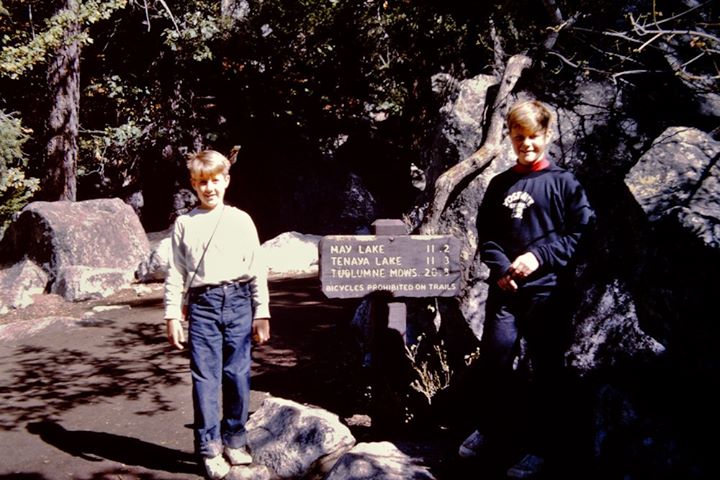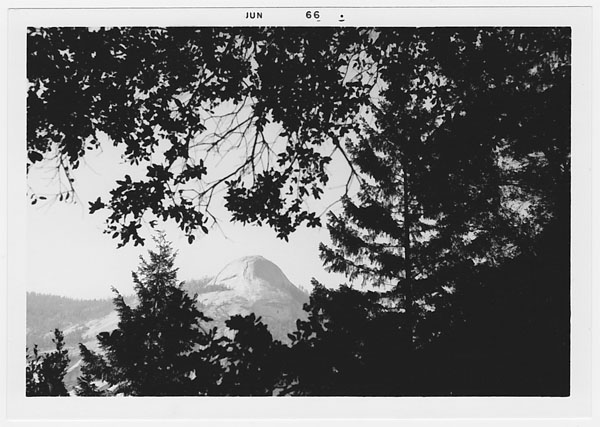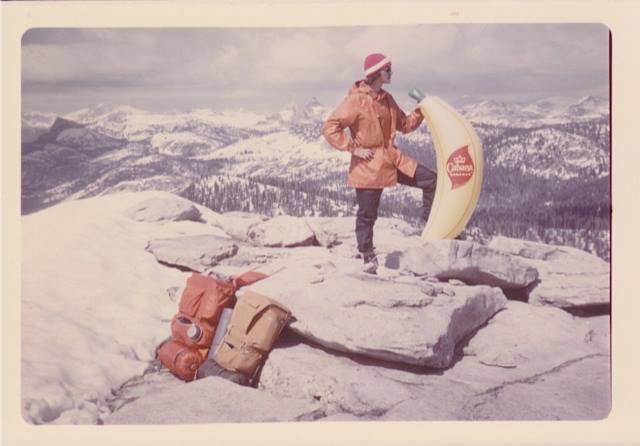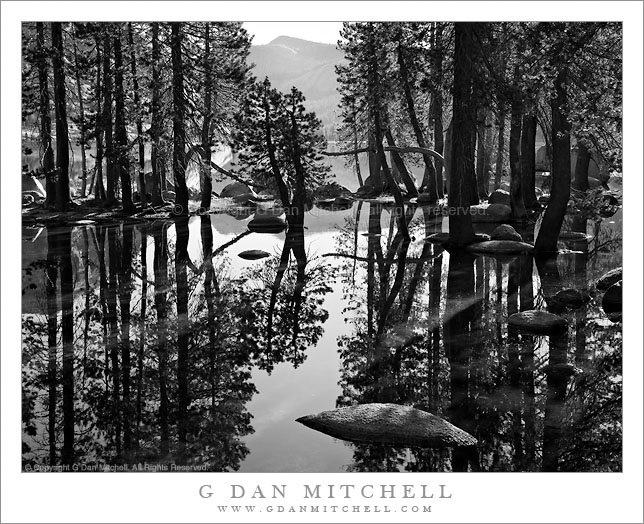It was 150 years ago today on June 30, 1864 that President Abraham Lincoln signed a congressional act that established the “Yosemite Grant” in the Sierra Nevada — the first instance of the US government setting aside land specifically for preservation and public use. (Technically, Yellowstone became the first “national park,” when it was established in 1872.) Between that first act of preservation and protection, the park passed through several intermediate stages including management by the state and by the military before it became a national park on October 1, 1890. (Little known fact: Beautiful Mount Conness, on the northeastern park boundary and visible from many areas between Olmsted Point that peaks near Tioga Pass, was named after senator John Conness, who was instrumental in getting the 1864 act through congress. Some have suggested that Lincoln was distracted by “other events” at about this time, and may have let this slip by without much attention. I’m fine with that.)

My family moved from Minnesota to California when I was four years old — and trust me, that was not recently! I’m sure that to Midwesterners the wonders of California must have seemed quite unbelievable, and my family travelled to many interesting places around the state. I don’t now recall for certain when I first visited Yosemite, though I think it was perhaps before this photograph was made. That’s me on the right and my brother Richard on the left. (Richard is also a photographer who does beautiful work in the Pacific Northwest.) My first clear recollection of the park is actually from just outside the park where, before the current mega hotels were constructed, there used to be a bunch of much smaller places to stay right along the Merced River. My memory is of sitting on metal chairs and watching the wild Merced River pass by.
The next specific memory I have — and I hope I have these in the right order — is actually a photography memory, if you can believe that. My father had given/loaned me some sort of camera that I believe used 120 film, as many inexpensive cameras did in those days. By this time I had been bitten by the Sierra Nevada bug, though I was still way to young to do anything about it on my own. Looking through my Dad’s photography books at home got me dreaming and thinking about these things. On this visit, which was apparently in 1966, we camped in the Valley (and perhaps elsewhere), hiked to Sentinel Dome (where I made an exceptionally boring photograph of “Ansel’s Tree”), and hiked the popular trail to Vernal Fall. On the way back I recall catching a view of North Dome, a sight that thoroughly intrigued me. That dome seemed utterly remote and high and may have exemplified the high country that I dreamed about. I also recall getting some idea of making a photograph of it that was not just pointing the camera at the thing and clicking, and what I did next, I now realize, bridged two themes that later became important to me — exploring and looking for a better way to see things. I found a place where I could leave the trail and I clambered up a small but steep slope where, in my memory today, I found a flat spot well above where everyone else was on the trail and where I could silhouette North Dome in a frame of dark tree branches.

(Yeah, way too much black stuff on the right and especially at the lower right, but still… this is the first one that I remember.)
Later my father, who had apparently done some camping back in his youth in New York State and who had then made a heroic (by mid-century standards) move to Wyoming, decided that he wanted to take us backpacking… but it turned out that weather and (I suspect, in retrospect) his own doubts and fears prevented us from getting beyond the Tuolumne Meadows campground, even through we arrived with mountain tents, backpacking food, sleeping bags, and all the other usual stuff. But by now, the interest in the country beyond the trailhead had taken a firm hold on me, and a few years later I managed to take my first backpack trip at the age of sixteen. (I’m still amazed that my parents let me and two buddies take off into the backcountry near Lake Tahoe for a week with no adult supervision!)
Though my first trip was further north, by the time I got to college Yosemite became my primary Sierra Nevada outlet, and by this time I was a confirmed backpacker and soon to be a cross-country skier and occasional climber. College buddies and I backpacked in the park, mostly starting in the Valley. There is, perhaps, no logical explanation for the following photograph from this period.

I know that banana has your attention, but note the cool vintage backpacking gear, complete with Sierra cup hanging off the pack. At look at all that snow! What a sight, given this year’s drought!
The next years/decades become complicated, but I can share a few highlights. I took my future wife, Patty, on her first backpack trip (along with her brother Greg) in the Hetch Hetchy area. That trip was memorable for many reasons, but one story always stands out. We were camped, perhaps somewhere in the Rancheria Creek area, in the style of that era — sleeping bags laid out on top of a plastic ground cloth. (Tents were for sissies. Wealthy sissies!) That night I heard “something” investigating the area around our camp. So did Patty, who asked in a worried voice, “Did you hear that?” I, knowing full well that it was likely a black bear, innocently replied along the lines of “I didn’t hear anything.” The sound came again, as did the worried question, and I probably said something like, “It’s probably just a squirrel.” At about this point I realized that the squirrel bear was pretty much right on top of our camp, so I did what any self-respecting backpacker would do — I sat bolt upright and screamed at the bear. At which point Patty — who miraculously did forgive and then marry me — realized that we are being attacked by ax murderers.
Some years later I introduced all three of our kids to backpacking in Yosemite, each with an individual trip with me when they turned three. The outlines of the trip developed into a bit of a tradition. We would drive to the park and camp somewhere the first night. The next day we would park at the May Lake trail and load up packs — mine a gigantic 70 pound “dad pack,” and the current three-year-old carrying a cut little pack containing a stuffed animal and a toothbrush. We walked the one mile to May Lake, taking as long as four hours (!) and as little as one hour, and then spent a few lazy days at the Lake. At the age of five, the trip went to Lower Cathedral Lake, where my oldest was so entranced by coming across a family with a mule that he simply walked up, took the rope, and began to walk off with it! At the end of each trip there was a triumphant stop at the Meadow Grill for burgers and fries.
Throughout all of these years I continued to visit the park, doing a bit of climbing in the Valley. (The highlight was a climb of Snake Dike, the story of which is worth its own post. Trust me.) I also extended my backpacking range, becoming a lifelong fan of the higher Sierra of the Kings Canyon and Sequoia NP back county, which began to more and more distract me from Yosemite. I backpacked there extensively, including three 13-15 day trips, one of which was my first solo backpack trip.
Through all of this I continued to carry cameras. My early serious devotion to photography perhaps reached a peak at about the time I turned 30, when I would head out with one or more 35mm film bodies, dozens of rolls of film and a few lenses. But then something changed. I began to enjoy the backcountry experience so much that the photography began to feel like an intrusion of that. I continued to carry cameras and photograph, but I gradually reduced the amount of equipment — from SLR to small rangefinder to even smaller “Stylus” zoom, and I found a new joy in not focusing on photography but instead focusing on the pure experience of being in the Sierra.
To this day I have mixed feelings about that period. I most definitely enjoyed the deep experience in the mountains, and at times I felt as connected to that world as I ever have. Yet I also regret that I did not take advantage of that period to make photographs.

But in the late 1990s the pendulum began to swing back toward photography, and by the new millennium I was again carrying a camera. Only this time I felt that the photographic experience intensified the experience of the back county instead of interfering with it, and I became more and more focused on the photography, until today I can hardly imagine going to this beautiful park without a camera.

 G Dan Mitchell is a California photographer and visual opportunist whose subjects include the Pacific coast, redwood forests, central California oak/grasslands, the Sierra Nevada, California deserts, urban landscapes, night photography, and more.
G Dan Mitchell is a California photographer and visual opportunist whose subjects include the Pacific coast, redwood forests, central California oak/grasslands, the Sierra Nevada, California deserts, urban landscapes, night photography, and more.
Blog | About | Flickr | Twitter | Facebook | Google+ | 500px.com | LinkedIn | Email
Text, photographs, and other media are © Copyright G Dan Mitchell (or others when indicated) and are not in the public domain and may not be used on websites, blogs, or in other media without advance permission from G Dan Mitchell.
Discover more from G Dan Mitchell Photography
Subscribe to get the latest posts sent to your email.

Great write up, Dan. Brought back similar memories from my own childhood spent in the Sierra. Many thanks.
Alan